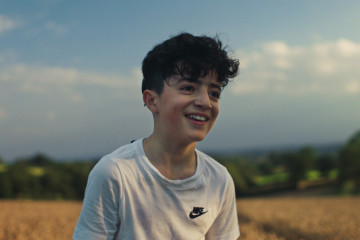

Language deprivation is seldom explored in movie productions. In hearing societies it is heralded as a portal through which we channel our innermost thoughts, but language is not always universally accessible.
This was Lawand Hamad Amin’s experience, a 12-year-old deaf Kurdish boy who is the protagonist of writer-director Edward Lovelace’s latest introspective documentary feature — Name Me Lawand — an immersive portrait of a young adolescent boy and his raw determination to learn British Sign Language (BSL), like an infant taking its first steps.
"The film immerses in Lawand's sensorial world, where sound is faint and high-frequency vibrations are palpable beyond the screen. The resulting soundscape is intrinsic to the story being told"
The 12-year-old Kurdish boy left Iraq for Derby when he was a toddler and spent half of his life without specialised education and language. My name is, were the first words he expressed through signing aged seven.
The film immerses in Lawand's sensorial world, where sound is faint and high-frequency vibrations are palpable beyond the screen. The resulting soundscape is intrinsic to the story being told.
Born in the Kurdish Region of Iraq (KRI) to hearing parents, Lawand was too young to comprehend the deplorable treatment he experienced at school and in public.
His closest ally and guardian was Rawa, his elder brother, but even he was unable to lift the trap door that kept Lawand locked out of society and trapped in his mind — unsure of his own name and place in the world.
|
His arrival to Derby upon the instructions of a good samaritan that the family met at a refugee camp in France, placed Lawand on a different trajectory.
He became a student at the Royal School for Deaf Derby where sign language altered his life, tested his mettle, and provided access to a world he was discovering for the first time, from making friends to enjoying simple boyish pleasures.
"Through dynamic filming sequences which include ground level, eye level and low-angle shots, Lovelace renders Lawand’s interiority and evokes his emotions"
His language of choice, BSL, is the backbone of the deaf community but unattainable back in Iraq where barriers to special needs education are rife, and where Lawand was encouraged to use his limited speaking voice.
Through dynamic filming sequences which include ground level, eye level and low-angle shots, Lovelace renders Lawand’s interiority and evokes his emotions. Moments of anger and joy are felt with equal force.
The most powerful sequence is Lawand’s first encounter with a drum kit during a session with Sophie, his teacher and deaf artist and activist, with an electrifying on-screen presence.
His eyes widen with joy and enchantment as his body interconnects with the sounds of the drum kick, from the pressure of the snare drum to the clapping of the cymbals; carrying shades of the Hollywood blockbuster, The Sound of Metal.
While the story is centred on a single character’s progression with language, the sequence of events presented in the film is not linear. Lovelace weaves in and out of Lawand’s life in Derby and former life in Iraq. He intersperses the present moment with flashbacks of the family’s tempestuous journey out of Iraq.
This is achieved through re-enactments involving actors, and more importantly through archival footage filmed by Iraqi filmmaker and producer of the documentary, Beyan Taher, who visited and recorded Lawand and Rawa’s real school and family home.
At the film’s BFI preview, Beyan told The New Arab that archival footage was key to conjuring distant and fragmentary memories, which helped contextualise the story and render the past visible while anchoring it in real-time.
As a fellow Iraqi, I am reminded of the multiple lives Iraqi families live and the fragments of traumatic experiences they endure and carry with them, and equally, the ways that migration and assimilation are nothing short of a contortionist act, fraught with challenges.
"The real star of the show however was Lawand who stood before jurors and judges and defended his right to remain, speaking not through others but for himself"
The biggest challenge for the Amin family was the Home Office, whom they battled against for years to keep their son in Derby, close to his friends and school which he considered a second home.
Since the family arrived in the UK from Germany, that was the destination the Home Office threatened to send them back to, despite having put down roots in Britain where Lawand had started to shed some of his past trauma.
The attempt was fuelled by the retrograde belief that Lawand could learn another language. Their greatest fear was the possibility of being forcibly returned to war-beat Iraq, where deaf education and provisions are unheard of; non-existent. Whether in Iraq or Germany, the damage would have been fatal for Lawand, tearing him away from his support network.
For years, the family were on a knife-edge but the local community in Derby would not let up. From neighbours to school teachers and language specialists, everyone rallied behind the family and lobbied local authorities.
The real star of the show however was Lawand who stood before jurors and judges and defended his right to remain, speaking not through others but for himself. Through collectivisation and compassion, the family won a reprieve from the threat of deportation.
Where Lovelace and his hybrid team of hearing and deaf producers and filmmakers’ have succeeded most is in making a film that widens our gaze about language development and migration, while championing self-agency and the importance of family, including the unbreakable bond between brothers, and the importance of allyship in shaping inclusive societies.
Nazli Tarzi is an independent journalist, whose writings and films focus on Iraq's ancient history and contemporary political scene
Follow her on Twitter: @NazliTarzi








